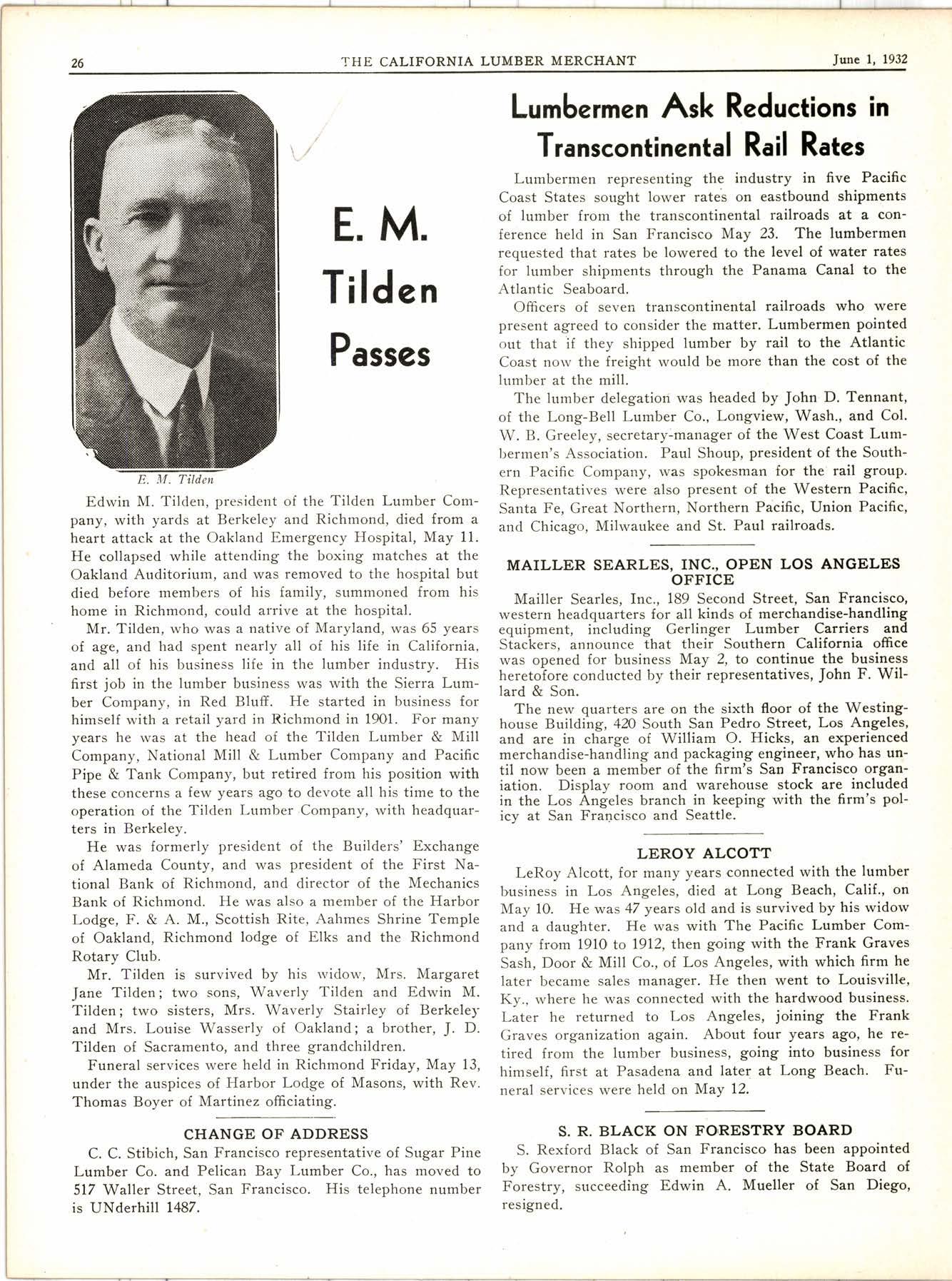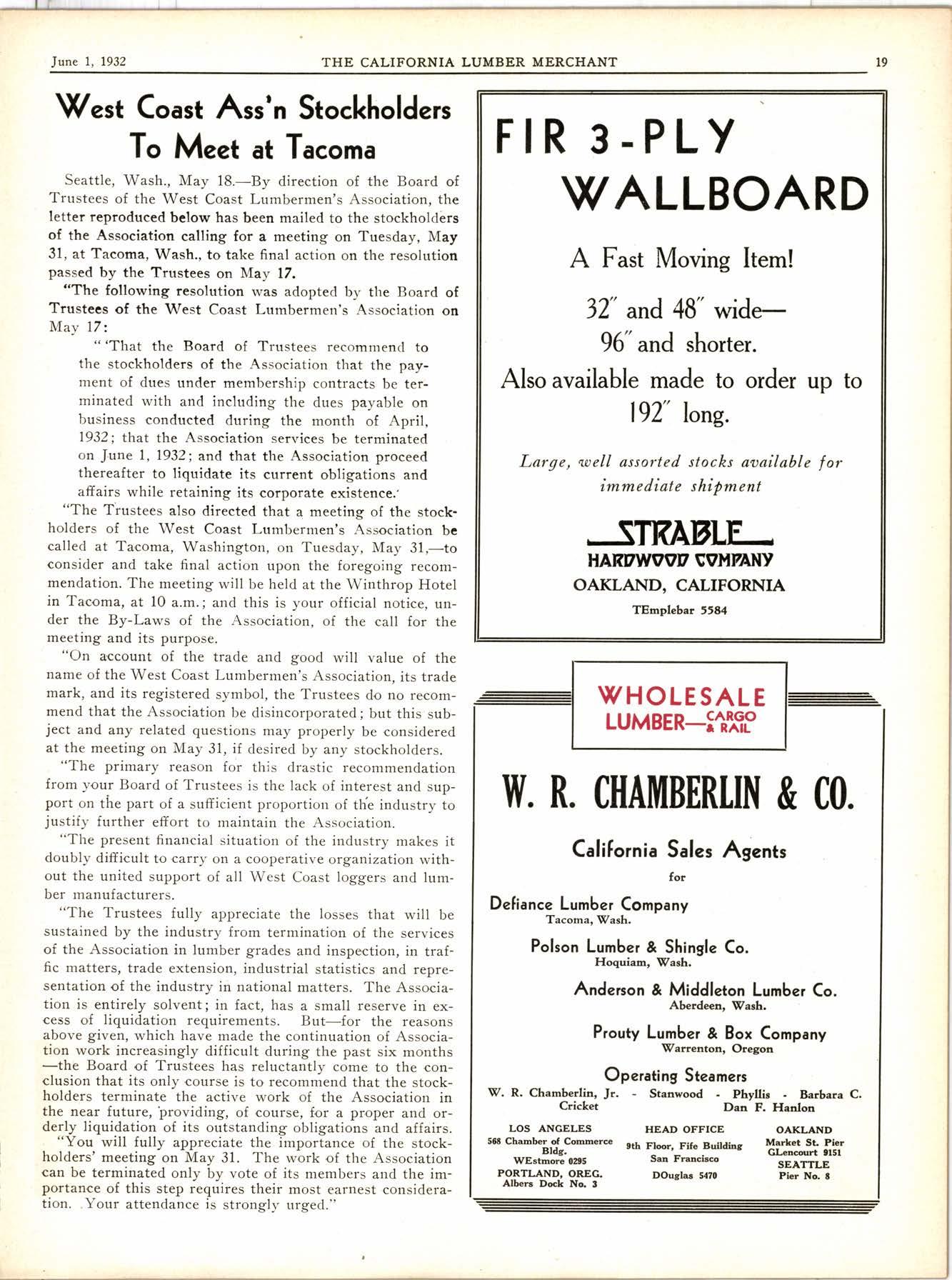
7 minute read
\(/hat The Lumber lndustry Nceds
Bv J. P. \(eyerhaeuser, Jr. President, Potlatch Forests, lnc., Lewiston, ldaho
I should like first to give a brief pi,cture bf ttre present condition of the manufacturing end of the lumber business. Companies with which I am familiar operated in'1931 on the basis of donating their timber, the use of their sawmills, and the use of their logging railroads or other major improvements in the hope that current'cash income would exceed the cash outgo. To some small degree in this way, plus inventory liquidation, money was made available to meet timber land taxes and carrying charges, interest, etc. The year L932 to date reflects somewhat worse conditions. Without question the measuring stick of the entire industry today throughout all its ramifications of plants and logging operations in favored locations or not, owing money or not, and operating owned stumpage or not, is its cash position. It is obvious that conditions as described are depleting the capital structures of the industry at a terrifying rate.
Were this, as in the ,case of most industry, directly tra,ceable to the present world economic ,condition, the situation would be serious enough, but lvhen it can be proven that the 'capital assets of the lumber industry were being depleted at a rapid rate even during the inflated conditions of 1929 and in the years before, it becomes apparent that to prescribe for the ills of the industry is more than a twenty minute job. The situation is so serious that we are inclined to become hysterical in the remedies which we demand from public and other bodies and forgetful of the huge task we have always to face in putting and keeping our own house in order.
The problem is so complex and the causes so deep rooted and involved that no one unit in the industrv can do mu'ch. by itself, in discovering and prescribing the remedies. Nor can the industry itself do much except by the sincere mutual consideration of all its members in all its bran,ches and as well by the industry's silent partners-the public, the railroads, the banks, etc.
The public itself, nationally and locally, has by far the largest stake in the lumber industry thro,ugh its timber ownership, its interest in payroll and community stabilization, and in a hundred and one other ways. But in spite of this very real partnership between thb lumber industry and the public through the years, it has always seemed to me that the desires of the industry have been viewed with distrust and suspicion. The reasons for this feeling are varied. Perhaps the fact that the industry itself has more times than not been divided in its desires has had a large influ- ence. The various conservation movements in the country have been directed more against the lumbermen than with them, and have given rise to the belief that a lumberman was an individual with a limitless pocketbook, accumulated largely as a result of his exploitation of the public's play grounds, and beauty spots in a questionable fashion. For years antagonism existed between lumbermen, and those who wished the lumbermen to do those things which would keep all the forests beautiful and green, without a very definite idea of either what measures were necessary or their practicability.
The,preachments of this group did much to promote the feeling even among lumbermen themselves, thal they were dealing in a commodity which was vanishing. This encouraged speculation in timber, and did mu.ch to encourag'e the continuous rise in market values of stumpage. Today there is a far greater harmony of viewpoint. The lumberman knows he is broke, and so does everyone else. There is a general realization that lumber is loiing its markets. This, togethir with a greater knowledge of the actual supply, has punctured the speculative value of timber. We now know that the ,country's forests can be managed as to provide ample lumber and forest products for the country's future needs. ft seems to me that if this existing partnership is to be presented to the public as something worth contin,uing, then the public must be shown its own definite interest in those handicaps which have been placed upon us and which are beyond our own unaided ability to reduce and eliminate.
The period of rising stumpage values coincide with a period of greater material development of timbered regions previously remote. Schools, highways, and local governments have been extended to the isolated bodies of timber. The inevitable result has been the building up of assessed valuations and tax levies to a point where the pressure to liquidate become enormous. Coincident with rising taxes came the realization that stumpage values were receding. These facts and an urge to fatten public treasures by liquidation of public timber as well, have so encouraged construction of plant {acilities, that today there is lumber productive ,capacity in existence 50 per cent in excess of the requirements of the best year in the past decade.
To aocomplish what is needed for the industry requires that tlre industry and its leaders so sell themselves and their problems to their public partners, as to make them willing bedfellows. The chief prerequisite to this is the industry's so organizing itself as to be a cohesive and effectivb unit itself.
I do not attempt to recite these handi'caps in the order of their importance nor to make a dogmatic assertion that we cannot greatly strengthen our position without their complete'elimination. I mention them because they are unfair and because, in my opinion, the publi,c permits them to exist because it does not understand its own opportunities in its partnership with us.
That transportation 'costs are a far greater proportion or the delivered price of lumber than it can stand is incontrovertible. Lumber, in the last decade has become a typically long-haul commodity. I seek no sectional advantage for any group when f say that it is radically unfair to expect longhaul rates to take up all the slack resulting from the railroads'loss of short haul business. The situation has become one which sharply favors the distribution of 'competitive substitutes and as it now stands is intolerable.
Our tariff situation as it affects lumber and other forest products is a very unhappy one. Through favored national clauses, empire preferentials, monopolies, and one means and another, it is now apparent that the domestic market has become practically the only market for American lumber manufacturers. But in this, our own market, we bre not adequately protected. We have not been a strong single unit in the presentation of sur tariff ideas. We can not be while part of us has one eye on Canadian timber holdings. Still it occurs to me that domestic capital and labor have every right to protection under the conditions.
For timber to pay an annual ta-x rvithout regard to its current earning power is very unfair. It is there to see, and consequently has been taxed out of all proportion to su,ch properties as lie beneath the ground and are invisible or such properties as produce an annual revenue. The only basi,cally fair method of taxing timber is on a yield tax basis.
Much more economy should be introduced into govern- ment. \Me should lend our aid to the public in establishing and maintaining minimum balanced budgets of public ex-penditure. The solution of this problem involveJ redu,cing to and maintaining at a minimum those governmental func-tions which actually the government shbuld perform. Industry should, so far as practicable, perform research or other work in their own field without attempting to have it don-e "free" by the government. Industry sh-ould take back for internal performance work of this kind which is no_w an unne,cessary burden on government. Industry and other responsible economic groups in cooperation should more effectively plan for sound government brganization for the elimination of unnecessary governmental ma,chinery such.for example, as the elimination of unnecessari countres.
Production ,control is a crying need of all industry, and also of lumber. 'We must have the sympathy, undeistanding, and help_of our public partners in-our-efiort to help ourselves in this matter.
Strong trade associations seem to me to be the immediate and obvious method of procuring orderly marketing and production in the lumber industry, to th6 extent thit the benefits of trade association government are lost throueh our anti-trust laws. I believe we need revision or ndw interpretation of those laws. Without the trade asso,ciation being able to g'overn through trade agreements, the tende-ncy must be toward physical mergers throughout the industry.
In this emergen,cy temporary production control measures have centered around voluntary control of sawmill operations. The Special Lumber Survey Committee of the "United States Timber Conservation -Board" in a series of quarterly reports is recommending redu,ction of excess stocks by production ,control. Rigional Associations through appropriate committees are interpreting and and transmitting such recommendations to individu;l lumber manufacturers. Each manufacturer in turn decides in the light of general conditions and his own cir,cumstances to what extent he will voluntarily carry out such recommendations. This process when aided by-powerful economic fa,c- tors as at present, is helpful in periods of depression, but must be recognized as only a partially effective and temWrary stop-gap. Efforts to make this temporary control more effe.ctive must be, in my opinion, viewed with considerable care, lest rve waste oui efiorts o.n what can at best be temporary, since not sawmill control but timber con- trol is the fundamental essential.

We especially need the understanding help of the oublic in order to build upon this fundamenta-l faci. Fores^t land o_wners (and always remember that the greatest of these is the- public) should re.cognize that without produ,ction con- trol overproduction may ,continue for decides, that control- of_ produ-ction to be effective in the long run must be applied to timber rather than sawmills, tfrat control of timber cutting must_be-applied both to public and private timber, and especially in the west, ,cooperatively to these two classes of timber; that sustained yield foresi manasement is a form of control of timber cutting completelfin the public's interest both as a timber ownir and throleh its manifold other interests in the industry. Conseouent"lv the prin,ciple of sustained yield management is a goal
(Continued on Page 12)










